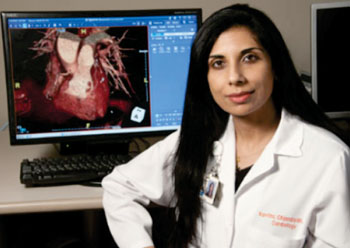Newer Generation, Dual-Source CT Scanners Cut Radiation Exposure to Patients
By MedImaging International staff writers
Posted on 03 Jul 2014
Computed tomography (CT) scans are a recognized standard of care for identifying heart and lung disorders. However, clinicians have concerns that the growing use of CT scans could be putting patients at a higher lifetime risk of cancer from radiation exposure. New research has revealed that the use of the latest advances in CT scanning technology is helping to tackle this important concern.Posted on 03 Jul 2014
The new findings, published in the June 20, 2014, online issue of the Journal of Cardiovascular Computed Tomography, consisted of 2,085 patients at nine centers in the United States and the Middle East, and revealed that using newer generation, dual-source CT scanners substantially reduced radiation exposure for patients when compared with first generation, 64-slice, single-source scanners or first generation, dual-source CT scanners.

Image: “Newer technology makes a difference in terms of radiation exposure and the difference is quite large,” says study author Kavitha Chinnaiyan, MD, director of Advanced Cardiac Imaging Research at Beaumont Hospital, Royal Oak (Photo courtesy of Beaumont Health System).
Patient radiation exposure was reduced by 61% with the newer scanners, with no significant difference in image quality for patients having CT scans for coronary artery disease, pulmonary embolism or aortic disease. “Newer technology makes a difference in terms of radiation exposure and the difference is quite large,” stated study author Kavitha Chinnaiyan, MD, director of advanced cardiac imaging research at Beaumont Hospital, Royal Oak (MI, USA). “It is important for patients to ask questions when referred for a radiation-based test to understand what the procedure involves and what the risks are of the particular technique and if there are alternative imaging choices.”
In addition, the study has significant implications for referring physicians. “Clinicians must understand that imaging studies not only have a major impact on the care of an individual patient, but also on trends in radiation exposure, as well as overall healthcare costs,” noted Dr. Chinnaiyan. “Incidental findings may require further imaging studies with other radiation-based tests. In addition to choosing patients appropriately, it is important to discuss the risks and benefits of testing with patients, and to refer them to centers that offer newer technologies.”
The findings, according to the researchers, provide vital information that will help in setting standards for radiation safety quality control in cardiovascular imaging.
Related Links:
Beaumont Hospital, Royal Oak














